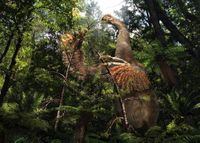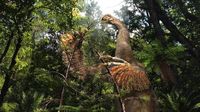In a remarkable discovery in Mongolia's Gobi Desert, scientists have unveiled a new dinosaur species named Duonychus tsogtbaatari. This unique creature, which lived approximately 90 to 95 million years ago during the Cretaceous Period, is part of the therizinosaur group, known for their distinctive features and herbivorous diet. The findings were published in the journal iScience on March 25, 2025.
The fossilized remains of Duonychus tsogtbaatari were unearthed during a construction project for a water pipeline in Southern Mongolia. According to Anthony Fiorillo, executive director of the New Mexico Museum of Natural History & Science (NMMNHS) and co-author of the study, the workers on the pipeline project were vigilant. “The people working [the] pipeline construction project kept their eyes open, saw that they had just uncovered something interesting, and then made a phone call or two, and that's how it ended up coming into our interest,” Fiorillo explained.
This dinosaur measured about 10 feet (3 meters) long and weighed approximately 575 pounds (260 kg). Unlike its therizinosaur relatives, which typically possessed three clawed fingers, Duonychus had only two. This distinctive feature is reflected in its name, which translates to “two claw.” The dinosaur's claws were notably curved and measured about a foot (30 cm) long. Fiorillo noted, “There’s very convincing evidence that these hooks were bringing branches of leaves to the mouth of the animal. … You can almost think of the hooked claws as oversized barbecue tongs, that they're bringing the food from the tree to the mouth.”
The discovery of Duonychus adds a fascinating chapter to the story of therizinosaurs, a group that has long intrigued paleontologists. These dinosaurs are characterized by their rotund bodies, long necks, small heads, and massive claws. Despite being part of the theropod clade that includes carnivorous giants like Tyrannosaurus rex, therizinosaurs were primarily herbivorous.
Yoshitsugu Kobayashi, a paleontologist from Hokkaido University Museum in Japan and lead author of the study, described Duonychus as an extraordinary example of evolutionary adaptation. “Therizinosaurs are some of the weirdest dinosaurs ever. They were theropods — so, related to meat-eaters — but they looked like giant feathered sloths,” Kobayashi said. “Duonychus takes that weirdness even further. It had this short, two-fingered hand with claws like a raptor, but it used them to eat plants. It’s like evolution said, ‘Let’s try something totally new.’ And it worked.”
The research team noted that the skeleton recovered was incomplete, lacking its skull and legs. However, the arms and hands were well-preserved, with one claw retaining its outer keratin sheath, the same material found in human fingernails. This keratin sheath added more than 40 percent to the claw’s length, providing valuable insights into the dinosaur's biology. “These were big, sharp and nasty claws,” said Darla Zelenitsky, a paleontologist and co-author of the study from the University of Calgary in Canada. “That’s incredibly rare,” Kobayashi added, “and it gives us an extraordinary window into how these dinosaurs actually used their hands in life.”
The claws of Duonychus may have served multiple purposes, primarily for foraging leaves from trees, but they could also have been used for grappling, defense, and possibly even species recognition. Zelenitsky remarked, “They could have used the claws for other purposes as well, perhaps for grappling, defence, digging and maybe even recognising one’s own species — ‘Hey, look at me. I also have only two fingers.’”
This discovery also sheds light on the evolutionary phenomenon known as digit reduction, where species lose fingers or toes over time. The earliest dinosaurs had hands with five fingers, while the first land vertebrates had eight digits. Today, there are at least five lineages of theropods known to have independently evolved with just two fingers on each hand, highlighting the diverse evolutionary paths these creatures have taken.
In discussing the implications of this discovery, Zelenitsky suggested that fewer fingers may have been advantageous for Duonychus. “With dinosaurs that grasped vegetation during foraging, one would think more fingers would be better. That was obviously not the case with Duonychus, as its hand construction with two fingers seemed to suit it just fine. I suspect it may have had a specialised feeding behaviour or food source,” she said.
The excitement surrounding the discovery of Duonychus tsogtbaatari reflects a broader trend in paleontology, where new dinosaur discoveries are occurring at an unprecedented rate. Fiorillo noted, “There are so many people in the field looking for fossils or visiting existing museum collections with new eyes, fresh experiences, that the discovery of new dinosaurs is occurring remarkably quickly. There may be a new one in the works for next week, really.”
This surge in discoveries is fueled by a new generation of paleontologists eager to explore uncharted territories and uncover the secrets of the past. “There are just whole groups of young graduate students, young professionals, that are eager and hungry to make new discoveries, and they're starting to probe around the globe in places that we haven't gotten to yet,” Fiorillo added.
As researchers continue to unearth fossils and study these ancient creatures, the findings will not only enhance our understanding of dinosaur biology but also help revise the scientific community's understanding of ancient biogeography — the study of how plants and animals are distributed across the planet.
The discovery of Duonychus tsogtbaatari is an exciting reminder of the mysteries still hidden beneath the Earth’s surface, waiting to be uncovered by those brave enough to dig deep into the past.





